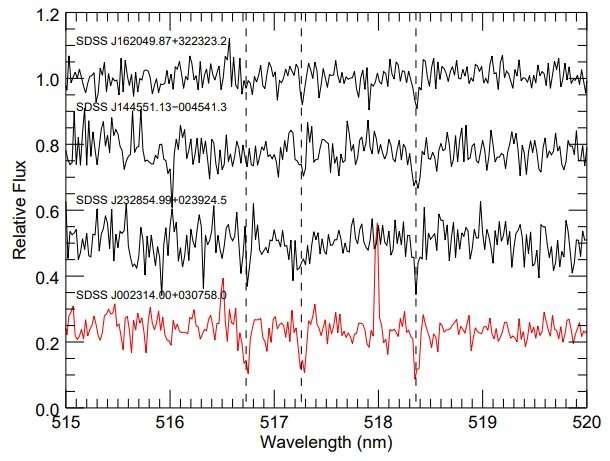X-Shooter spectra of the stars centered on the magnesium triplet. The continuum of the three spectra located in the lower part of the plot has been shifted downward for clarity. The vertical lines indicate the location of the magnesium absorption lines. Credit: Francois et al., 2018.
An international team of researchers has conducted a chemical study of six new very metal-poor star candidates in the Sloan Digital Sky Survey Data Release 12 (SDSS DR12). The new research, available in a paper published August 29 on the arXiv pre-print repository, could help researchers better understand the early stages of chemical evolution of the galaxy.
Extremely metal-poor stars (EMPs) are generally perceived by astronomers as the relics of the early chemical evolution of the Milky Way galaxy. They can be crucial in advancing the knowledge of the nature of the first stars that formed in the universe as their chemical composition is an important tool for constraining the nucleosynthesis in the first generation of stars.
Thus, a group of scientists led by Patrick Francois of the Paris Observatory in France has performed a chemical analysis of a sample of new EMP candidates from the SDSS DR12. They chose six stars from the database and obtained medium resolution spectra of these objects utilizing the X-Shooter spectrograph at ESO's Very Large Telescope (VLT) in Chile. The observations resulted in determining chemical abundances of these stars.
"From the recent analysis of SDSS DR12 data, we have detected new extremely metal-poor candidates that have never been observed at high resolution. In this article, we report the detailed analysis of six new extremely metal-poor candidates observed with the X-Shooter spectrograph installed on Kueyen at the ESO Very Large Telescope (VLT) on Cerro Paranal in Chile," the researchers wrote in the paper.
Metallicity of the six studied stars ranges from -5.0 to -3.5 [Fe/H], while their effective temperature is between 6,050 and 6,530 K.
The researchers found that three stars of the six described in the paper are calcium (Ca) poor. They noted that the magnesium to iron (Fe) abundance ratios of this trio also appears rather low.
The authors report that five stars of the sample show abundance ratios typical for metal-poor stars in the metallicity range between -3.5 and -2.0. However, one dwarf star in the sample, designated SDSS J002314.00+030758.0 (or SDSS J0023+0307 for short), showcases abundance anomalies. The scientists found that it has remarkably high magnesium (Mg) and calcium abundances.
"We can see that the star SDSS J002314.00+030758.0 stands out, revealing very high overabundances of Mg and Ca sharing this peculiarity with Keller's star (SMSS J031300-670839.3) and to a lesser extent Depagne's star (CS 22949-037)," the paper reads.
According to the researchers, the anomalies found in SDSS J0023+0307 suggest different channels for the enrichment of the gas that formed most metal-poor stars observed today.
The scientists concluded that several different astrophysical processes could be behind such anomalies in SDSS J0023+0307, which include the explosions of supernovae and very rapid rotation of stars. However, more chemical studies of extremely metal-poor stars are needed to determine the most plausible hypothesis.
More information: Chemical analysis of very metal-poor turn-off stars from SDSS-DR12, arXiv:1808.09918 [astro-ph.GA] arxiv.org/abs/1808.09918
Abstract
The most metal-poor stars are the relics of the early chemical evolution of the Galaxy. Their chemical composition is an important tool to constrain the nucleosynthesis in the first generation of stars. The aim is to observe a sample of extremely metal-poor star (EMP stars) candidates selected from the Sloan Digital Sky Survey Data Release 12 (SDSS DR12) and determine their chemical composition. We obtain medium resolution spectra of a sample of six stars using the X-Shooter spectrograph at the Very Large Telescope (VLT) and we used ATLAS models to compute the abundances. Five stars of the sample have a metallicity [Fe/H] between -2.5 dex and -3.2 dex. We confirm the recent discovery of SDSS J002314.00+030758.0. As a star with an extremely low [Fe/H] ratio. Assuming the alpha-enhancement [Ca/Fe]=+0.4 dex, we obtain [Fe/H]=-6.1 dex. We could also determine its magnesium abundance and found that this star exhibits a very high ratio [Mg/Fe] >= +3.60~dex assuming [Fe/H] = -6.13 dex. We determined the carbon abundance and found A(C)=6.4 dex. From this carbon abundance, this stars belongs to the lower band of the A(C)-[Fe/H] diagram.
© 2018 Phys.org
























